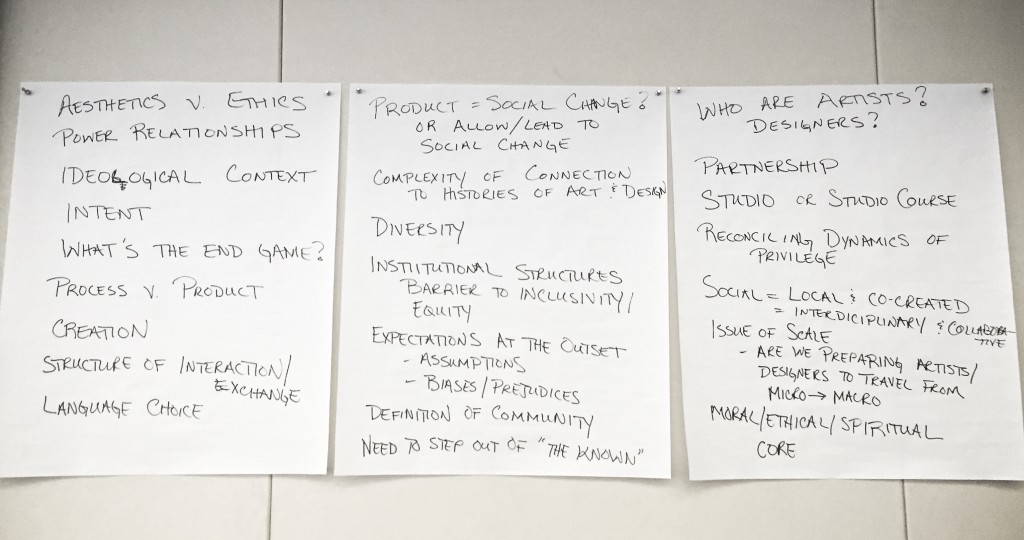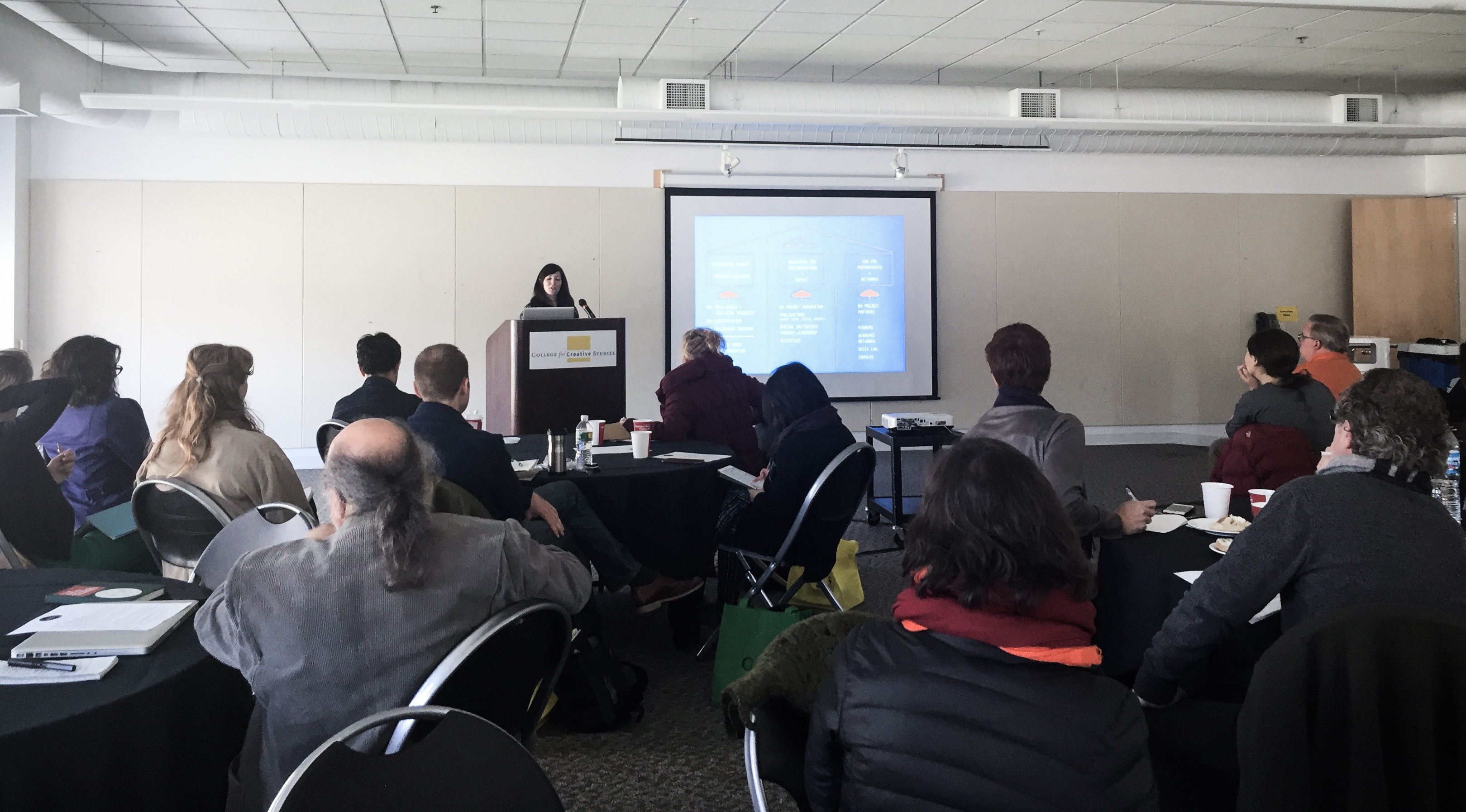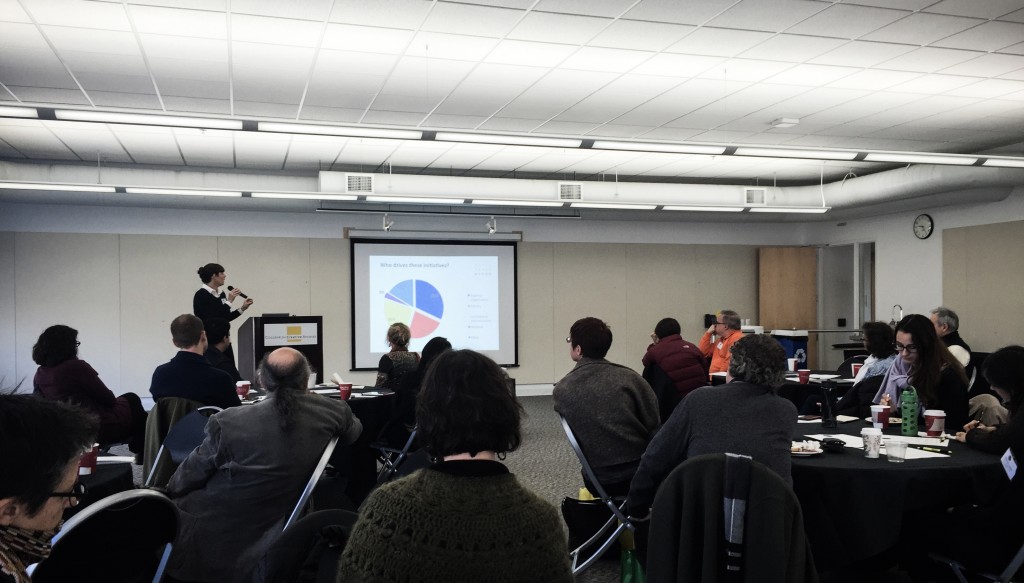Media Design Practices Graduate Student, Esther Park writes about her recent trip to the AICAD Social Practices Conference & PALS Summit in Detroit Michigan.
 In Detroit, Michigan – College for Creative Studies (CCS) partnered with the Association of Independent Colleges of Art & Design (AICAD) to organize a social practices conference for a number of schools to come together to be immersed in a conversation around design, art and social practices. For the past three years, AICAD has been tracking growth in the number of schools implementing courses, majors, minors and graduate programs focusing on a social practice in fine art and design. With the intention of creating a unique dialectical space for these schools on how socially engaged art and design practices were promoted in their programs, Designmatters and the Media Design Practices Graduate program along with many other Art & Design institutes were invited to participate and present at this conference.
In Detroit, Michigan – College for Creative Studies (CCS) partnered with the Association of Independent Colleges of Art & Design (AICAD) to organize a social practices conference for a number of schools to come together to be immersed in a conversation around design, art and social practices. For the past three years, AICAD has been tracking growth in the number of schools implementing courses, majors, minors and graduate programs focusing on a social practice in fine art and design. With the intention of creating a unique dialectical space for these schools on how socially engaged art and design practices were promoted in their programs, Designmatters and the Media Design Practices Graduate program along with many other Art & Design institutes were invited to participate and present at this conference.
As a Graduate Media Design Practices Field student at ArtCenter College of Design, I was invited to attend the conference as the student representative with Jennifer May, Director of Designmatters, and Anne Burdick, Chair of Graduate Media Design Practices. Not only was it exciting for me to visit Detroit for the first time, but it was also intriguing to be able to listen and engage in the conversations that were aimed at understanding how art, design and social practices are all interconnected and what it looks like as fully formed degree programs to faculty and staff members making connections between students, community organizations and other resources. Topics that were presented included Practice & Pedagogy in Community Arts, Institutions Supporting and Sustaining Social Practices, and Connecting Social Design and Corporate Sponsored Projects. Some of the questions that arose from these presentations through public and private conversations varied from:
- “Who are artists/designers?”
- “What is the end goal?”
- “What kind of partnership do we need?”
To more complex questions such as:
- “How do designers and artists step out to ‘the unknown’?
- “What kind of structure of interaction/exchange is needed?”
- “How do we define our work and community?”
On the final day, followed by hours of intense dialogue and presentations, we were also graciously taken on a tour to learn more about how public arts were involved in addressing challenges and celebrating opportunities in Detroit. We were taken to see various art projects founded out of the Community Arts Partnerships (CAP) of CCS and Community + Public arts: Detroit (CPAD) in the neighborhoods around CCS, and also had the chance to listen to what their main community partners have to say about the impacts that these projects have made in their neighborhood.
You can check out the projects here:
Making a Splash : “The Illuminated Mural” / Aesthetics and Utility: “Earth Sky Repose” / Empowering Partners : “The Oakland Avenue Artists’ Coalition (OAAC)” / The Power House / Play House / Sound House
Although I felt as if the majority of the discussions were focused more on arts than design, it was nevertheless encouraging as a graduate student to witness how many different programs, faculty members, and communities had acknowledged the growth, the need and the importance of socially engaged art and design practices to be pursued in academia. Not all questions that were asked were paired with answers, but I don’t think this space was necessarily organized to find answers for this future field of social engaged art and design practices. Rather it was designed to acknowledge one another’s trial and errors, to bring ideas forward, and to walk away with more questions to ask ourselves as we continue to tackle this new field for future educators, artists and designers. As I was leaving Detroit, the following “what if” questions that one of the presenters had asked during the conference remained:
- “What if artists designed the curriculum or the process to educate?”
- “What if artists made themselves available and accessible at all times?”
- “What if artists allow subjects to become the artists and speak for themselves?”
These questions are something I would like to keep asking myself as I continue to engage in my own design practices in the graduate program.
To learn more about Esther and her work please visit, www.esparyi.com and connect with her here.

